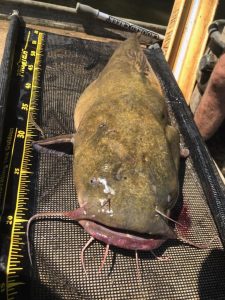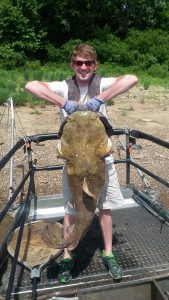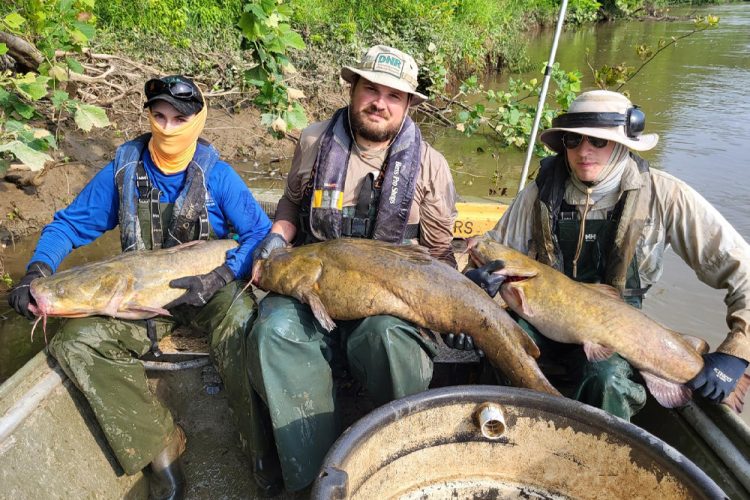The Indiana Department of Natural Resources is currently involved with one of the largest catfish research projects in the agency’s history. Here, fisheries biologists show some of the big flatheads caught using a trotline while surveying catfish in the Wabash River, a tributary of the Ohio River. (Photo courtesy of Indiana DNR)
The Future Looks Bright for Ohio River Flatheads
By Richard Hines
For many years, there had been trouble between Indiana and Kentucky, at least on the basketball court. But just as the rivalry between these states waned, fisheries biologists from these neighboring states began working together to monitor and hopefully improve the future of flathead catfish in the Ohio River.
Catfish have always seemed to have taken the back seat in fisheries research. As you might have guessed, bass, crappie and other species have been well studied, but only recently have catfish moved from the recipe book to the trophy records book. Catfish, including flatheads, are now front and center with the pro-tournament circuits. One area of the country where they are receiving top billing is Kentucky and Indiana. Fisheries biologists in both states are studying the mainstem of the Ohio River along with several tributaries that are being closely monitored.

Kentucky began significant catfish monitoring and research in 2004. Heading up the program for the Kentucky Department of Fish and Wildlife Resources (KDFWR) is fisheries biologist Jay Herrala. Herrala took over the department’s rivers and streams program in 2012 and since then has ramped up both research and surveys for catfish along the Ohio River. Kentucky remains one of the few states along the Ohio River that allows commercial harvesting of catfish. KDFWR’s goal is to provide catfish for recreational anglers and commercial harvesters. Commercial fishing has a long history in Kentucky, and it was not too many years ago that every river town was home to commercial fishermen who made their living on the river.
KDFWR is in a balancing act of making sure commercial anglers don’t fish themselves out of a job while assuring recreational anglers have plenty of fish. This is a tough balancing act.
Just across the river in Indiana, Phillip Kacmar who is the Big Rivers Fisheries Biologist for the Indiana Department of Natural Resources, Division of Fish and Wildlife (INDNR) is involved in Indiana’s biggest catfish research project to date. “Many anglers who were fishing the Wabash and the White Rivers thought these rivers had been fished out,” he said. “But we are finding decent flatheads…[indicating] the river still has a good fishery.” The question always remains, is it as good as 50 years ago?
Biologists from each agency have been asked about some of the historical information on big cats of the past, but Herrala said, “There were always big catfish on our larger rivers, but the question is this: are these rivers better or worse? No one really knows because long trend data from the 1940s and 1960s is lacking.”
Even though many of these rivers were top fishing locations, little or no data exists making it impossible to make any comparisons between then and now.
Both agencies are keeping a close check on populations of all three species of large catfish, not only in the mainstem of the Ohio River but several tributaries. Survey methods include the use of trotlines, electrofishing and hoop nets.
In Kentucky electrofishing is used to sample every pool (above locks and dams) along the Ohio except the Greenup Pool, which is mainly along the West Virginia border. In the last few years, KDFWR has also begun collecting data on sections of the Green and Kentucky rivers. Both are major Ohio River tributaries.
Today both agencies are keeping pace with the interest in catfish by building long-trend data and monitoring short-term trends. Herrala said, when thinking back to the “good ole days,” everyone remembers the good times, but he said, “Remember, rivers are very cyclic systems, and no matter the species, whether crappie or catfish, all are affected by temperatures and flows” Only after these agencies have built long-term data will we fully understand how these species are doing.

Interesting Finds
KDFWR biologist Herrala said although catfish grow slow, he is not concerned about the Ohio River. Kentucky researchers have found some of the older catfish documented in scientific literature include a 35-year-old flathead!.
If you have fished for catfish for any length of time, you know the importance of large trees in rivers, particularly those that have been in place for some time. INDNR biologist Kacmar said, “When we are electrofishing and approach a downed tree that has been in place for some time, there will be a flathead wedged under that tree. While these fish will also hang around riprap, trees appear to be their top choice. But, surprisingly, these flatheads tend to run a little smaller.”
“We are now seeing good numbers of trophy catfish,” Kacmar said. “In the short-term portion of the study, it gets down to low flows verse high flows, which has affected the results”. This is one of the reasons research projects are scheduled for several years, which allows researchers to look at long-term trends.
Some Flatheads are Travelers, Some are Not
Indiana DNR has been working with graduate students from East Illinois University and Ball State University collecting age data, an important parameter used to develop trends that help biologists understand survival, reproduction and recruitment. Researchers are tagging every catfish collected that is over 10 inches long. Kacmar said, “So far in 2025, we have tagged around 500 fish.”
Interestingly, some flatheads are homebodies, barely moving a few hundred feet their entire life. Others have been recovered over 40 miles from their original capture site, making it obvious catfish have individual characteristics.
Kentucky and Indiana are Not Alone
In 1999, all states along the Ohio River understood the need to work together to properly manage the river. The result was the Ohio River Fisheries Management Team, comprised of biologists and directors from Illinois, Kentucky, Indiana, Ohio, West Virginia and Pennsylvania. Agencies continue working independently, but now they share data, allowing researchers to detect noticeable trends, all of which will benefit catfish populations for years to come.
(Richard Hines is a retired wildlife biologist, book author and award-winning freelance outdoor writer and photographer. Since 1985, Hines has published hundreds of articles on hunting, fishing, conservation and natural history. He and his wife Pam enjoy traveling where they are rarely without fishing rods. To date Hines has fished in 37 states and counting.)



